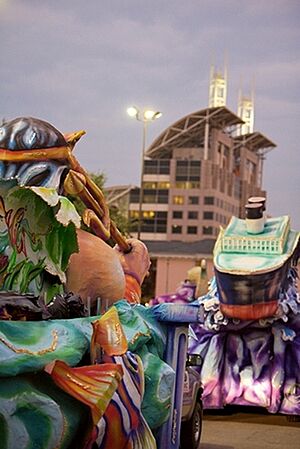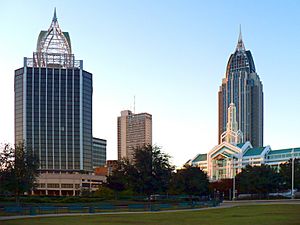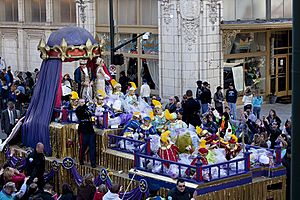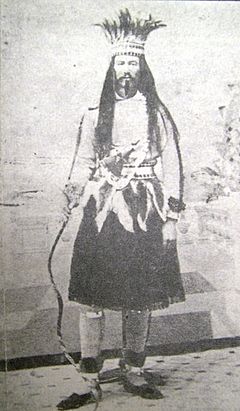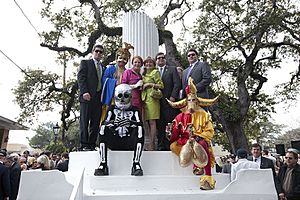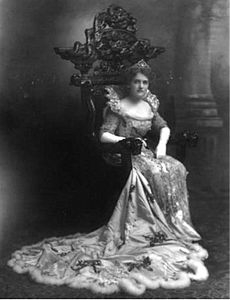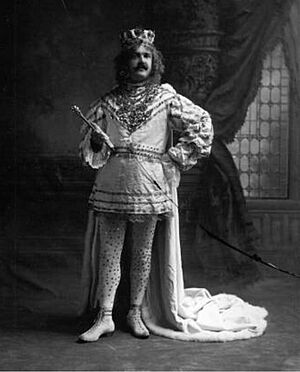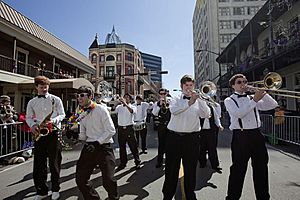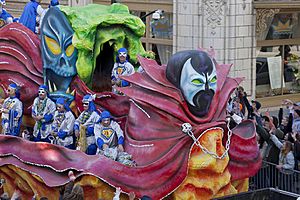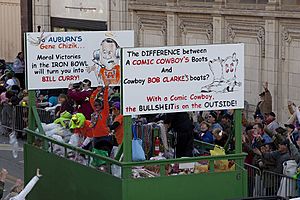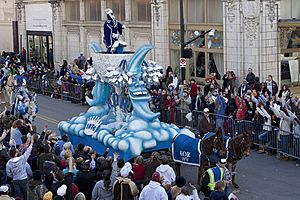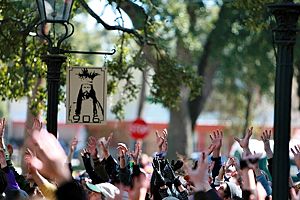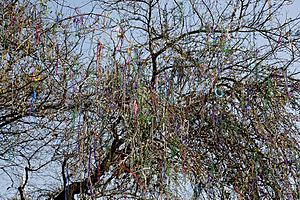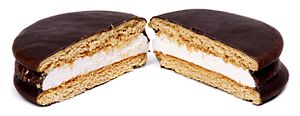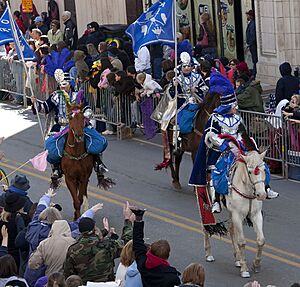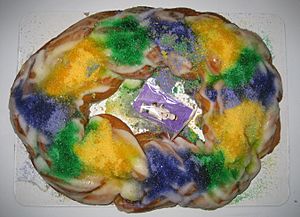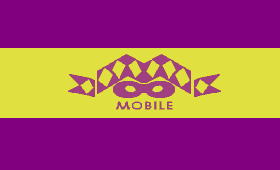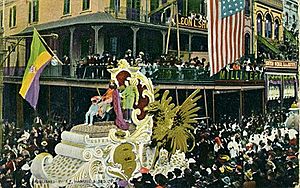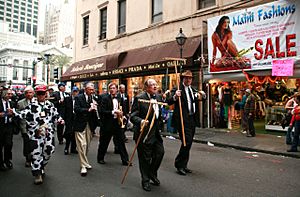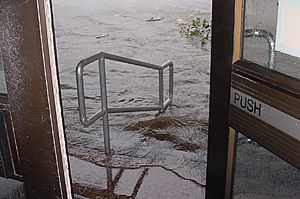Mardi Gras in Mobile, Alabama facts for kids
The first unofficial American Mardi Gras happened on March 3, 1699. French explorers Pierre Le Moyne D'Iberville and Sieur de Bienville landed near what is now New Orleans, Louisiana. They had a small party and named their landing spot Point du Mardi Gras. Many other unofficial French celebrations took place along the Gulf and Atlantic coasts during the 1600s.
Mardi Gras is also the yearly Carnival celebration in Mobile, Alabama. It is the oldest official Carnival celebration in the United States. A Frenchman named Nicholas Langlois started it in 1703 when Mobile was the capital of Louisiana. Today, the New Orleans and South Louisiana celebrations are more famous. However, many traditions like masked balls, parades, floats, and "throws" (gifts tossed to crowds) first started in Mobile.
Since Mobile was the first capital of French Louisiana (starting in 1702), the festival began as a French Catholic tradition. Mardi Gras has now grown into a big, multi-week celebration for people of all backgrounds. It has even become a school holiday for the last Monday and Tuesday (and sometimes Wednesday) before Lent, no matter what religion people follow.
Mobile has traditions of special clubs that hold fancy masked balls and wear elegant costumes. But over the last 300 years, the celebration has mostly become known for public parades. During these parades, members of these clubs, often wearing masks, ride on floats or horses. They toss gifts, called "throws," to the people watching. Throws can include colorful plastic beads, special coins called doubloons, decorated plastic cups, candy, wrapped cakes like Moonpies or snacks, stuffed animals, and small toys.
The masked balls or dances are usually for adults. Men wear formal suits, and women wear long evening gowns. Some of the special clubs treat these balls as part of their social season. Many nightclubs and local bars also have their own Mardi Gras events.
Besides the public parades, Mardi Gras involves many different mystic societies. Some started as early as 1704, while others formed after the Civil War. New societies have also appeared in every century. Some mystic societies never appear in public parades. Instead, they hold private, invitation-only events for their secret members, with balls starting in November each year.
Contents
What is Mobile Mardi Gras?
The Mobile Mardi Gras season begins in November with special parties held by some secret mystic societies. Then come the New Year's Eve balls. For some families, it's also connected to the social season where young people are introduced to society. Other mystic societies start their events on Twelfth Night (January 6). This is when parades, balls (some of them masquerade balls), and king cake parties begin.
During the last two weeks before Mardi Gras Day, at least one big parade happens every day in the city. The largest and most detailed parades take place in the final few days of the season. In the last week of Mardi Gras, many events, big and small, happen all over Mobile and nearby towns.
Parades in Mobile are mostly organized by mystic societies or orders. Members riding on floats toss "throws" to the crowds. The most common throws are colorful plastic beads, doubloons (metal or wooden coins with a club's logo), wrapped candy or snacks like MoonPies, decorated plastic throw cups, stuffed animals, and other small, inexpensive toys. The main clubs follow the same parade schedule and route every year.
For people in Mobile, Mardi Gras means the entire festival season, also called Carnival. Local schools have several "Mardi Gras Holidays," which often include Ash Wednesday. Mobile's culture is very diverse. Because of this, the Mardi Gras season has grown. The area's traditions come from its long history, including French, Spanish, British, African, Creole, American, and even Swedish influences.
History of Mobile Mardi Gras
French Catholic settlers brought a type of Mardi Gras festival to Mobile. This was because Mardi Gras was part of getting ready for Ash Wednesday and the start of Lent. The first time this holiday was recorded in America was on March 3, 1699, at a camp along the Mississippi River delta. After Fort Louis de La Louisiane was built in 1702, soldiers and settlers celebrated Mardi Gras starting in 1703. This began a yearly tradition, which was only stopped a few times because of wars.
Mardi Gras has changed over 300 years in the Mobile area. It mixes old traditions and culture with new ideas. French Mardi Gras arrived in North America with the French settlers, the Le Moyne brothers, Pierre Le Moyne d'Iberville and Jean-Baptiste Le Moyne de Bienville. In the late 1600s, King Louis XIV sent the brothers to protect France's claim on the land called La Louisiane. This land included what are now the U.S. states of Alabama, Mississippi, and Louisiana.
The two explorers first arrived at Dauphin Island in what is now Alabama. They sailed up the mouth of the Mississippi River (which Cavelier de La Salle had mapped in 1682). On March 3, 1699, they celebrated and named the spot Pointe du Mardi Gras. This spot was 60 miles downriver from the wild area that would become New Orleans. Meanwhile, in 1702, 21-year-old Bienville founded the settlement of Mobile (Alabama). It was the first capital of French Louisiana. In 1703, the American Mardi Gras tradition began with French yearly celebrations in Mobile.
The feasting and fun on Mardi Gras in Mobile was called Boeuf Gras (which means "fatted ox"). Masked balls, with the Masque de la Mobile, started in 1704. The first known parade was in 1711. Mobile's Boeuf Gras Society paraded on Mardi Gras with 16 men pushing a cart that carried a large papier-mâché cow's head.
By 1720, Biloxi became the second capital of Louisiana and also celebrated French customs. Because of worries about tides and hurricanes, the capital moved to New Orleans in 1723. New Orleans was founded in 1718. That city also later started its own Mardi Gras celebration.
In 1763, Mobile came under British control. Their rules caused many Creole people to leave Mobile and move west toward New Orleans. In 1780, Spain took control of the Mobile area after the American Revolution. The Carnival celebration then included the Spanish custom of torch-lit parades on Twelfth Night (January 6, also known as Epiphany). In 1813, Mobile became a United States city, part of the Mississippi Territory. In 1817, it was part of the Alabama Territory. In the Anglican and Episcopal traditions, the day before Ash Wednesday was called Shrove Tuesday. People would eat rich foods on this day before the fasting of Lent.
In 1830, a group of people led by Michael Krafft stayed awake all New Year's Eve. They started a parade at dawn on January 1, 1831, making noise with cowbells, hoes, and rakes. This group became the first parading mystic society. They called themselves the Cowbellion de Rakin Society, making fun of French words. They had yearly parades each New Year's Eve. Almost 125 years after Mobile's first parade in 1711, members of the Cowbellion de Rakin Society took their parade tradition to New Orleans in 1835. They eventually formed the Mistick Krewe of Comus.
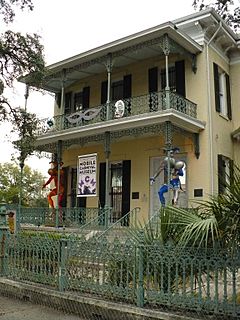
In 1843, some men who were not allowed to join the Cowbellions formed the Striker's Independent Society with their own New Year's parade. The Boeuf Gras Society held their last parade on Shrove Tuesday in 1861, before the start of the American Civil War. Then they broke up.
In 1867, after the Civil War ended, Joe Cain brought back the parade tradition in Mobile on Mardi Gras. He rode in a decorated charcoal wagon with six other veterans. This event has been celebrated yearly with Joe Cain Day since 1966. The Joe Cain Day parade happens on the Sunday before Mardi Gras. The event's founder, artist and historian Julian Lee "Judy" Rayford, played the "Chief." In 1970, he passed the role to the third "Old Slac," fireman J. B. "Red" Foster. Foster played the "Chief" until 1985, when he passed the role to historian and pastor Bennett Wayne Dean Sr. Dean, as Old Slac IV, celebrated his 25th year as the "Chief" on Joe Cain Day in 2010.
Sometimes, wars, money problems, politics, or bad weather caused some or all major parades to be canceled. This happened especially during the Civil War and World War II. However, the city has always had some kind of Mardi Gras celebration.
Traditional Colors
| Mardi Gras colors and meanings | |
|---|---|
| Justice (purple) | |
| Faith (green) | |
| Power (gold) | |
The traditional colors of Mardi Gras in Mobile have been purple and gold. Purple has been linked to royal families in Europe. It is also the color used in church services during Lent in Christianity. Many people in Mobile now also use a third color, green. This might be because of New Orleans' traditional colors of purple, green, and gold. Those colors came from the Russian House of Romanov in 1872. They were adopted when Grand Duke Alexis Romanoff Alexandrovitch, who was the brother of the person next in line to the throne of Russia, accepted New Orleans' invitation to attend Mardi Gras. The celebrations were held in his honor.
Mystic Societies
The first mystic society in Mobile started in 1704. It was called the Societé de Saint Louise and was founded by French soldiers at Fort Louis de La Louisiane. The yearly Masque de la Mobile also began that same year. In 1830, a group celebrating with an early morning parade, later known as the Cowbellion de Rakin Society, held the first parade in Mobile society.
Dozens of mystic societies have appeared and disappeared over the past 300 years in Mobile. Members have included co-workers, single men, women, Black people, Black women, Jewish people, married women, married couples, or groups open to anyone, including visitors. There are currently more than 40 mystic societies in Mobile. Many of them are secret societies, so it's hard to know their full impact on Mobile's politics, businesses, and Carnival activities. However, they have been another way for people to have social and political influence.
Today, many mystic societies work like businesses. Membership is usually open to anyone who pays dues to have a spot on a parade float. In contrast, the older mystic societies were social clubs with secret member lists. If you told others you were a member of some societies, you could be kicked out. Some newer mystic societies actively look for new members. Some older societies have limited membership, with hundreds of people on waiting lists. Others only allow members who went to certain schools or follow other rules.
The oldest parading society in Mobile is the Order of Myths (OOM), founded in 1867. Its symbol shows "Folly" chasing "Death" around the broken pillar of life. This is a symbol of Mardi Gras in Mobile. Other well-known mystic societies include the Knights of Revelry (their symbol is "Folly" dancing on the edge of a huge champagne glass), the Comic Cowboys of Wragg Swamp, Infant Mystics, Mystics of Time, Crewe of Columbus, Mystic Stripers Society, Order of Inca, and Conde Cavaliers. Ladies' societies include the Order of Polka Dots (OOP), which is the oldest and largest ladies' society in Mobile, Maids of Mirth (MOM), Order of LaShe's, Order of Athena, Neptune's Daughters, and Mobile Area Mardi Gras Association (MAMGA).
Mardi Gras Today
Each year, the Mardi Gras (or Carnival) season starts with three main events: the November parties of the International Carnival Ball and the Camellia Ball, where the city's young women are presented. Then comes New Year's Eve and January 6, also known as Twelfth Night or the Feast of the Epiphany. In Mobile, the parade season usually begins three weekends before Mardi Gras Day with the Conde Cavaliers parade.
Parades
Starting two Fridays before Mardi Gras, there is usually at least one parade every night. The Wednesday before Mardi Gras is kept as a "rain out" day in case bad weather affects one or more of the earlier parades.
Many parades lead up to Mardi Gras day. On the Sunday before Fat Tuesday, Joe Cain Day celebrations are held. In recent years, these have included a joggers' run and the Joe Cain Procession, also known as the people's parade. You don't have to be a member of a mystic society to join the Joe Cain Procession. However, participants must now sign up with the city because too many people were joining in past years, making it unsafe. The parade is always led by Chief Slacabamorinico. He is currently played by only the fourth person in the city's long Carnival history to wear the "Chief's" feathers. He is surrounded by the Mistresses of Joe Cain, who wear red veils and dresses. They are followed by Cain's Merry Widows, who wail in black mourning clothes.
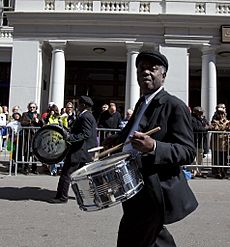
The Monday before Ash Wednesday is called "Lundi Gras" ("Fat Monday"). This comes from the French tradition of eating good foods on this day, as well as Tuesday, to get ready for eating less during Lent. In Mobile, Lundi Gras is usually a family day. Schools are closed on both Lundi Gras and Mardi Gras. At noon, the Mobile Carnival Association's Floral Parade is held. Local private and public schools provide floats and young riders. The Optimist Club hosts a family-friendly fair near Fort Conde. It has carnival rides, food, games, and activities. Lundi Gras is also a day for king cake parties and other family get-togethers in Mobile. As a tradition, after other parades, the Infant Mystics society has held its parade annually after 6 p.m. on this Monday night in downtown Mobile.
Celebrations start early on Mardi Gras day. Downtown, the long parade organized by the Order of Athena rolls first. It is followed by the Comic Cowboys, which started in 1884. The evening ends with a spectacular night parade of brightly lit floats decorated to a theme chosen by the Order of Myths. Each parade follows a set route so that people watching can plan where to stand along certain streets or balconies.
Some parades are long and go in a circle. This allows people to walk to a second viewing spot and catch more throws as the floats come back around. It also gives more time to see performances. Many smaller parades and walking clubs also parade around the city.
Exactly at midnight at the end of Fat Tuesday, all Mardi Gras celebrations stop. This is because it is the start of Lent. City workers quickly clean the streets of all signs of Mardi Gras for the next day. Local traditions suggest not wearing Mardi Gras beads during Lent. Both Catholics and other Christians often follow Lenten customs, like giving up certain foods or doing good deeds during this time of reflection.
Floats
Designing, building, and decorating Mardi Gras floats is a year-round job in Mobile. Several companies along the Gulf Coast do only this kind of work. The larger floats in Mobile's parades are made to hold about 15 or 16 adults and their throws. City rules set the length, width, and height of floats. This makes sure the floats can safely go through the narrow streets and tight turns downtown.
Floats usually have multiple levels, with a lower and upper level, and one or two middle sections (usually near the back of the float). The float "captain" usually rides on the upper level, which lets them see everyone on the float. For floats in night-time parades, the structures have lights, and a portable generator is pulled behind the float to provide power. Each float also has some type of portable restroom. From the street, a Mardi Gras float might look delicate, but they are actually built very strongly and can handle riders moving around a lot.
Some of Mobile's most famous floats include:
- Order of Myths Emblem: Folly chasing Death around the broken pillar of life.
- Knights of Revelry Emblem: Folly dancing in the goblet of life.
- Infant Mystics Emblem: A black cat on top of a cotton bale, which was the source of Mobile's wealth before the Civil War.
- Mystics of Time's Vernadean: A giant, rolling dragon float that breathes fire and smoke.
- Mystic Stripers Society: Two large, 40-foot-long emblem floats, one a fierce and "strong" Tiger, the other a sleek and "fast" Zebra.
- Crewe of Columbus' Nina, Pinta, and Santa Maria: Three floats built to look like Columbus's famous ships.
- Order of Polka Dots: Famous emblem showing three winged sons of Pegasus carrying the Golden Chariot of the Gypsy Queen through rainbow clouds.
- Order of Inca Messengers and Sun Worshippers: Some of Mobile's largest moving structures.
- Conde Cavaliers Emblem: A swashbuckler pointing his sword right at Mobile.
- Comic Cowboys: A series of funny comments on current events, both local and national.
- Mobile Area Mardi Gras Association (MAMGA) The Mollies
Throws
For many Mardi Gras parades in Mobile, Alabama, members of societies on floats toss gifts to the public. These gifts are called "throws." They include plastic beads, doubloon coins, decorated plastic cups, candy, wrapped cakes or snacks, stuffed animals, and small toys, footballs, frisbees, or whistles.
Mardi Gras throws have changed over the years. As recently as 20 years ago, the beads thrown by Mobile maskers were small, cheap plastic pieces. Few maskers thought much about them. Today, beads can be the most expensive items on a masker's throw list. In 1956, the first Moon Pies were thrown by children on the Queen's float in the Comic Cowboys parade. Moon Pies have since become a main throw at Mardi Gras in Mobile. Other items that have come and gone in Mobile's Mardi Gras history include Cracker Jacks (which were banned in 1972), confetti, and candy. Maskers throwing candy today usually toss small bags of bubble gum, kisses, and other sweet treats.
Mystic society members have thrown strings of beads from floats to parade-goers since at least the late 1800s. Until the 1960s, the most common types were custom-colored necklaces of smaller glass beads made in Czechoslovakia. These were replaced by cheap, strong, standard plastic beads. Lower-cost beads allow riders to buy more, so throws have become more common.
In the 1990s, many people lost interest in small, common beads, often leaving them on the ground. Larger, more detailed, multi-colored bead necklaces and strands with figures of animals, people, or other objects have become the popular throws. However, because throws are getting more expensive, maskers still buy and throw the smaller beads to most people. They save the more expensive, fancy ones for friends along the route.
One of the many Mardi Gras throws, doubloons are large coins, either plastic or metal, that are usually in the Mardi Gras colors. These coins show the mystic society's symbol, name, and founding date on one side. The other side shows the theme and year of the parade and ball. The Infant Mystics were the first Mobile mystic society to toss doubloons in the mid-1960s.
The doubloons thrown during the parade are inexpensive, stamped aluminum. However, a growing business has developed for making and collecting special, limited edition doubloons. To raise money, many societies now offer limited edition doubloons made from bronze, silver, gold, and platinum. Other types include cloisonné (decorated with enamel) and hand-painted ones. Instead of being stamped, these pieces are made like real coins. The Resurrected Cowbellion de Rakin Society made what have become the most unusual coins in Mobile Carnival history – the Belldallion – doubloons shaped like a cowbell.
In recent years, plastic cups have been thrown. The Order of Inca was the first club to throw plastic cups with their symbol and the theme of the parade and ball. Now, every mystic society in the city throws themed cups from their floats. Generic Mardi Gras cups are also thrown, often with the dates of future Mardi Gras seasons printed on them.
Snacks are usually wrapped, single portions of food. These can be a brownie cookie, snack cake, bag of peanuts, or a Moon Pie. Moon Pies usually come in chocolate, banana, or orange frosted marshmallow cake flavors. Over the years, new flavors like coconut, vanilla, mint, peanut butter, and salted caramel have been added. Tossed snacks have also included various bags of pork rinds crackers. Other snacks include dried fruits and whole bags of candy and gum.
A wide variety of soft plastic toys have become throws. These include hollow plastic water pistols or ribbed tube-straw whistles. The plastic toy Frisbees are usually small, with the round disc less than 8 inches (41 cm) across. Small footballs made of soft plastic or foam rubber have been thrown from floats. They are often made to spin like a full-sized football when thrown. Many of these have the Society's symbol or initials on them.
Prohibited Throws
Some items are not allowed to be thrown during Mobile parades. This is for safety reasons or other rules, as stated in Section 49 of the Mobile City Code (from February 10, 2004):
- "It is against the law for anyone to throw the following items from Mardi Gras floats or during Mardi Gras parades: Rubber balls, hard balls like baseballs, objects with wooden handles, dolls of any kind that are inappropriate, candy apples, ice cream or food that needs to be frozen or refrigerated, any canned food, whole boxes of any food, small decorative items, etc. All Moon Pies, small decorative items, and other throws must be thrown one by one or in small amounts." All boxes are not allowed as throws (also since February 2004), including "crushed or empty" boxes.
Costumes and Masks
On the days before Fat Tuesday (except at parties), people who are not part of a mystic society rarely wear costumes and masks in public. Sometimes, the general public may wear costumes or masks on Mardi Gras Day itself. Most people simply dress nicely, enjoying the outdoor atmosphere and the chance to socialize.
Mystic society members wear detailed costumes that match the theme of their parade, ball, or float. Costumes include custom-made hats or feather headdresses, though some societies don't require this. Most of the traditional clubs require riders to wear a mask that fully hides their identity. Cutting the mask too much or taking it off at any time during the parade can lead to being removed from some societies. Some mystic societies also require members to wear masks during the society's ball (which is usually held on the same night as its parade).
Since 1957, the general public has only been allowed to wear masks on Mardi Gras day from 9 a.m. to 9 p.m., or if they are members of mystic societies. This rule was put in place because of problems with masked bandits and also because of old connections to damage caused by the Ku Klux Klan.
Flambeaux Carriers
The flambeaux or flame-torch was originally a light for parade-goers to better see the night festivities. In Mobile, night parades used to be lit by torches with signal flares on top.
By the end of the 1900s, most burning flares were replaced by electric lights on the floats, powered by generators. The Order of Myths parade still uses people carrying flambeaux, which are fuel torches, on Mardi Gras night.
Commercialization
There is almost no advertising during the Mobile parades, as it was banned by law in 1935. The different floats in a parade are designed as separate creations. However, some mystic societies have thought about getting money from companies to help pay for things.
Other Traditions
King Cake
The first week of January marks the start of the king cake season. The traditional king cake was connected to Epiphany, January 6, also known as Twelfth Night. This was when English and Europeans celebrated Christmas for twelve days leading up to this night. The modern version is a coffee cake, and it is long and braided. The cake is covered with a simple icing and purple, green, and gold sugar. Each cake has a small hidden baby doll inside. According to tradition, whoever finds the doll must either buy the next King Cake or host the next King Cake party. In Mobile, people throw hundreds of King Cake parties every year, and thousands of cakes are made, bought, and eaten.
Mardi Gras Icons
Several common images or phrases appear during the Mardi Gras season:
- Official Mardi Gras flags: flags with a special symbol in Mardi Gras colors.
- Signs or items using traditional colors: purple, green, and gold.
- The faces of Comedy and Tragedy: the smiling and frowning theater faces.
- Feathered masks: with soft feathers attached at the edges.
- Fleur de Lis: the French symbol from when Mobile was the capital of the French colony.
- "Let the good times roll!" (French: "Laissez les bons temps rouler")
- "Throw me something, Mister!"
Comparing Mobile and New Orleans Mardi Gras
It's not easy to compare Mardi Gras in Mobile with celebrations in New Orleans. This is because of the many events in the 300-year history of Mardi Gras in Mobile. New Orleans also includes celebrations from many communities within the Greater New Orleans area. Both regions have dozens of parades and masked balls for adults. Both celebrations also include family-friendly activities, in addition to the wilder images that people often think of.
The histories of Mobile and New Orleans are closely connected. Both cities were the capital of French Louisiana in the early 1700s, and later, both were controlled by Spain. Mobile's yearly parades began with a Tuesday procession in 1711. However, the planned mystic society parades in Mobile started 120 years later and were held for New Year's Eve. New Orleans, on the other hand, developed a traditional Tuesday public procession on Mardi Gras day. Things mixed when former Mobile Cowbellions started planned Tuesday parades in New Orleans. This led to Joe Cain parading in New Orleans in 1865, and then in Mobile in 1867. Joe Cain's influence led to a yearly Joe Cain Day in Mobile, celebrated with a parade on the Sunday before Ash Wednesday. New Orleans has other traditions and does not celebrate Joe Cain Day.
The mystic societies or orders/krewes are different between the cities. Mobile's final parade, on Tuesday night, is put on by the Order of Myths. In New Orleans, since 1857, the final parade was put on by the Mistick Krewe of Comus, until they stopped parading in 1991. Now Mardi Gras ends with the parades of Zulu, Rex, Elks, and Crescent City. The official end of Mardi Gras in New Orleans is when the courts of Rex and Comus meet at midnight. Both clubs have held their balls on Fat Tuesday night for over a century. Rex and his queen and court leave their ball and go to the ball of the Mystic Krewe of Comus, as Rex is the newer organization.
After Hurricane Katrina
Like much of the Gulf Coast, many parts of Mobile were flooded by the strong storm surge from Hurricane Katrina on August 28–29, 2005. Some waterfront areas were underwater and hit by high waves. Downtown was flooded only a few feet deep, including the downtown parade routes. Despite these problems, enough of the routes were cleared to continue Mardi Gras celebrations. Mobile had its largest Mardi Gras ever after the storm. The next year, the 2007 Mardi Gras season in Mobile had about 900,000 people. Police estimated the total number of attendees at 878,000, with 105,600 people along the streets for the Fat Tuesday finale.
Glossary
The Mobile Mardi Gras season uses several terms that have special meanings for the events:
- Carnival: the festival season, usually from January 6 (Twelfth Night) to Mardi Gras (the Tuesday before Ash Wednesday).
- Lundi Gras: ("Fat Monday") the Monday before Lent.
- Mardi Gras: ("Fat Tuesday") the Tuesday before Lent. It also refers to the general several weeks of the Carnival festival.
- King Felix III: the current king of the Mobile Mardi Gras.
- Mystic society: a secret club formed for yearly Carnival events.
- Parade krewe: a society that has yearly, organized parades.
- Tableau: a pageant event, like a living picture.
- Throw: any gift tossed from a float to the people watching.
Images for kids



